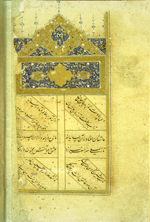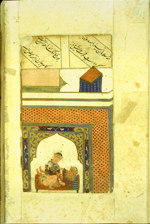Catalogue: Belles Lettres
-
 Kitāb Salāmān va Absāl (MS P 16)
Kitāb Salāmān va Absāl (MS P 16) - (The Book of Salāmān and Absāl)
- كتاب سلامان و ابسال
- by Nūr al-Din ‘Abd al-Raḥmān Aḥmad ibn Muḥammad Jāmī (d. 1492/898)
- نور الدين عبد الرحمن احمد ابن محمد جامى
Salāmān and Absāl are two characters that figure prominently in a series of medieval Persian philosophical and mystical allegories (see P. Heath, 'Salāmān and Absāl', EI 2nd edition, vol. 8, pp. 920-1). One of most famous of these allegories is the allegorical poem titled The Book of Salāmān and Absāl by the celebrated Sufi poet Jāmī.
The National Library of Medicine has an illuminated copy of Jāmī's Kitāb Salāmān va Absāl that also contains one miniature. The manuscript has not been used in any published edition, translation, or study.
For other manuscripts copies, see Keshavarz, "Wellcome", p. 525.
An edition of the poem was published as: Salaman u absal, An allegorical Romance: being one of the seven poems entitled the Haft Aurang, of Mulla Jāmī, now first edited from the collation of eight manuscripts by Forbes Falconer (London: Printed for the Society for the Publication of Oriental Texts, 1850). An English translation [by Edward Fitzgerald] was published anonymously as Salāmān and Absāl: An allegory translated from the Persian of Jāmī, (London, 1856) and then again in 1871 under the translator's name: Salaman & Absal: An allegory, trans. Edward Fitzgerald (Ipswich, 1871). See also A. J. Arberry, Fitzgerald's Salāmān and Absāl: A Study (Cambridge: Cambridge University Press, 1956).
Illustrations
A fine illuminated opening in gilt and opaque watercolors of a copy of Kitāb Salāmān va Absāl (The Book of Salāmān and Absāl), by Jāmī (d. 1492/898). The copy is undated, but appears to have been made in Iran in the 16th or 17th century.
A miniature painting, now slightly defaced, in opaque watercolors, gilt and inks, of a couple having sexual intercourse. From a copy of Kitāb Salāmān va Absāl (The Book of Salāmān and Absāl), by Jāmī (d. 1492/898). The copy is undated, but appears to have been made in Iran in the 16th or 17th century.
Physical Description
Persian. 59 leaves (fols. 1b-59a). Dimensions 18.1 x 11.5 (text area 13.4 x 8.1) cm; text written in alternating diagonal and horizontal panels. The title is given in the colophon (fol. 59a), and repeated twice in a later hand on folio 1a. The author is not named, but is identified by comparison with other known copies.
The copy is undated and unsigned. The appearance of the paper, script, inks, and illuminations suggest a dating of about the 16th or 17th century from a workshop in Iran.
A complete copy and illuminated copy.
It is copied in an elegant, professional, nasta‘liq script with alternating couplets written diagonally. The couplets are written in rectilinear areas outlined in fine ink and gilt frames within larger frames formed of black ink lines filled with green opaque watercolor and gilt. The headings are written in gold and blue inks.
On fol. 1b there is a fine illuminated opening head-piece in gilt and opaque watercolors. On fol. 35b there is a miniature painting, now slightly defaced, in opaque watercolors, gilt and inks, of a couple having sexual intercourse.
There are no catchwords or marginalia.
The thin, brittle, biscuit paper has laid lines only visible. It is badly worm-eaten and there is water damage to the last folio. Most of the leaves have been repaired and strengthened.
The volume consists of 59 leaves. Fol. 1a has miscellaneous owners' notes including one dated 1909 (AD), another assigning the volume the number '83' [in Arabic numerals], and an obliterated impression of an owner's stamp. Fol. 59b is blank except for a small casually written note.
Binding
The volume is bound in a red leather modern library binding with blind stamped floral decorations in the center of each cover, surrounded by frames filled with small blind stamped four-petalled flower-heads.
Provenance
Fol. 1a has miscellaneous owners' notes including one dated 1909 (AD) and an obliterated impression of an owner's stamp.
The volume was purchased in 1941 by the Army Medical Library from A.S. Yahuda (ELS 1557).
References
Schullian/Sommer, Cat. of incun. & MSS., P 16, pp. 334-5.
NLM Microfilm Reel: FILM 48-134 no. 4












